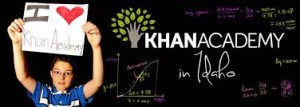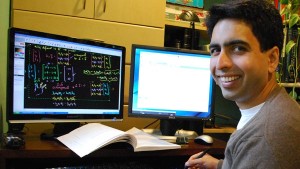
“You only have to know one thing … You can learn anything.”
www.KhanAcademy.org
| Offering |
Free online library of instructional videos. Covering multiple subjects, one step at a time, from beginner to advanced. |
| Value Proposed |
For Students Anywhere on Planet: For Schools: |
| Key Resources Leveraged | Internet (“absurdly underutilized technology”) Founder’s love of learning & gift for making knowledge accessible to all learner levels. Philanthropic dollars. |
| Societal Progress | “People” throughout society. People with more knowledge and more motivation to use it. |
1. The Offering
Online Library of Video Lessons
- For multiple subjects, brief videos address one topic at a time, from beginning level to advanced.
- Rewind and rewatch as many times as desired.
- Warm and conversational delivery conveys:
- Instructor’s respect for viewer customers, including conviction that anyone can learn anything, given mastery one step at a time.
- Instructor’s experience of the “sheer joy of learning” … “the thrill of understanding things about the universe.”
At one level, this free online library of instructional videos is like an inviting self-serve buffet:
 Every video is available to anyone, anywhere, for any purpose.
Every video is available to anyone, anywhere, for any purpose.- Many of the videos have been translated into multiple languages.
- Originally focused on mathematics, the library covers core academic subjects (e.g., science, art, computer programming, history) and more (e.g., SAT preparation, financial literacy).
- Each brief video focuses on one topic, or concept, at a time, situated within a menu that starts at the beginning level and proceeds, one topic at a time, to advanced levels.
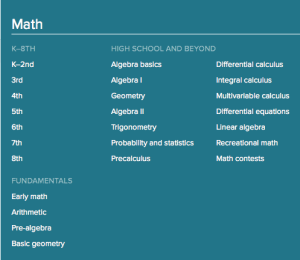
- Need help with quadratic equations? You can search for videos on that topic for instant help. What’s more, you can rewind and re-watch as many times as you like.
- Want to be sure you’re ready to learn Algebra efficiently? You can embark on a guided Pre-Algebra “mission” to address possible gaps in understanding of Pre-Algebra topics. Tailored assistance allows for filling the gaps and supporting your confidence in moving forward.
- Throughout subjects, online problems/quizzes/projects complement the video lessons, for practice, feedback that confirms mastery (or not), before moving on.
- Any individual anywhere can proceed through topics and subjects, going as fast, as far, and as deep as their personal goals and step-by-step mastery takes them.
At another level, the library of videos aims to “help us fundamentally rethink how schooling might be done.” There can be a fine dining type of usage, by individuals and schools alike.
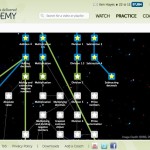 Every registered user has a dashboard summarizing activity — a self-management tool that can facilitate self-guided use of the videos and associated exercises, projects, etc.
Every registered user has a dashboard summarizing activity — a self-management tool that can facilitate self-guided use of the videos and associated exercises, projects, etc.- Plus, visual “knowledge maps” emphasize connections among topics, within and across subjects, with suggestions for where to go next.
- Schools, too, can opt to use the video library as robustly as their own goals and ideas take them.
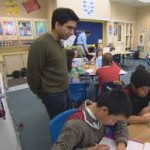 one early example, some schools approached the Khan Academy for support with initiatives such as “flipped” classrooms for math classes, where “homework” and “school work” are reversed: Students are assigned Khan Academy video “lectures” as homework. Then class time features working on problems, with teachers (and peers) circulating with help, challenges, and other interactions — “addressing difficulties as they occur” and providing teachers with feedback about student understanding.
one early example, some schools approached the Khan Academy for support with initiatives such as “flipped” classrooms for math classes, where “homework” and “school work” are reversed: Students are assigned Khan Academy video “lectures” as homework. Then class time features working on problems, with teachers (and peers) circulating with help, challenges, and other interactions — “addressing difficulties as they occur” and providing teachers with feedback about student understanding.- The Khan Academy worked with these and other pioneering schools to design instructional support tools (e.g., teacher dashboards) and to explore overall the potential for the video of libraries to serve as a complement to schools, for synergy and whole new possibilities for learning outcomes.
2. Hypothesis Behind the Offering
Agent’s Path:
Observation & Experimentation —
 First, in 2004, while working on Wall Street as a hedge fund analyst, Sal Khan, began tutoring his 12-year-old cousin, Nadia, via the internet, to prepare for re-taking a mathematics placement exam:
First, in 2004, while working on Wall Street as a hedge fund analyst, Sal Khan, began tutoring his 12-year-old cousin, Nadia, via the internet, to prepare for re-taking a mathematics placement exam:
- Since Khan knew his cousin as a motivated and capable student, it didn’t make sense to him that she would not have qualified for the higher level “track” of mathematics coursework. Worse, in Khan’s view, the placement results had led her to believe that she “just wasn’t good at math.”
- When Khan made a deal with Nadia that he would tutor her remotely if the school would allow her to re-take the exam, it represented “the very real potential to empower someone I cared about.”
As tutoring of Nadia led one step at a time to supporting more students, Khan repeatedly perceived unexpected discrepancies. For example:
- With additional extended-family tutees (which led to posting video lessons on You Tube), Khan found an unexpected extent of gaps in understanding fundamentals.

- “I was troubled … even shocked … that generally motivated and ‘successful’ students had only very shaky grasp of core material, especially math. They sort of half understood.” “These kids didn’t know math; they knew certain words and processes that described math.” p 133
- When Khan responded to a request to support a summer program for middle schoolers, a diagnostic feature programmed into the video library revealed gaps as basic as two-digit subtraction.
- Also, whereas Khan had expected the positive response he found from motivated and “successful” students to the more empowered learning opportunities, he was surprised by the extent of appreciation and new motivation expressed by students who had not been successful.
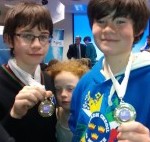
- He saw this firsthand with summer schoolers.
- He also received You Tube comments from the ever-increasing number of strangers using the online videos — up to tens of thousands of views daily — all before there was a Khan Academy.
- Khan not only began using all of his free time to keep adding videos to You Tube, he observed that a societal-level discrepancy between learning potential and the status quo was both urgent and … unnecessary.
- For the vast majority of students everywhere: “It’s about potential realized or squandered, dignity enhanced or denied.”
- Plus, the squandering was occurring at the “inflection point of an information revolution” throughout the world … “The pace of change is so swift that deep creativity and analytical thinking are no longer optional; they are not luxuries but survival skills.”
- And basic technology — “absurdly underutilized technology” — is a resource that could be readily harnessed to make a difference.
Hypothesis of “What Could Be” as New Value:
From the “absurdly underutilized technology,” create the value of a robust tool to support students’ learning success.
Based on premises like the following, a “Khan Academy” online library of videos could support the combination of rigor and learning efficiency. It could open up space for students’ personal interests, strengths, and creativity — in accord with real-world needs:
1. Anyone can learn anything if there is deep understanding of fundamentals. A video library could:
- Emphasize conceptual underpinnings of topics.
- Make mastery the constant across students. Instead of grades varying, self-pacing could vary, because success with subsequent content assumes mastery of what came before it. It could avoid “Swiss cheese brains,” and avoid “A’s” for short-term memorization (e.g., of formulas).
2. Free up schools to have more interactive instruction — to deepen learning. A video library could:
- Support schools in “moving up the value chain,” from information dissemination to more active learning.
- Allow for more: teacher-student interactions; peer-to-peer interactions; projects & applications that illustrate the academic content and deepen student understanding.
3. Learning efficiency in support of student agency & motivation. A video library could support deep understanding and promote the crucial element of student responsibility for learning:
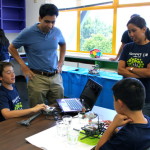 “From a student’s perspective, only by taking responsibility does true learning become possible.”
“From a student’s perspective, only by taking responsibility does true learning become possible.”- Given the unpredictability of the future: “The crucial task of education is to teach kids how to learn. To lead them to want to learn. To nurture curiosity, to encourage wonder, and to instill confidence.” (part four)
Sample Knowledge Connected in “What Could Be” Hypothesis:
Industry Knowledge (Education)
- Khan knew the U.S. system of K-12 “tracking” and of higher education admissions. He knew that Nadia’s math placement after sixth grade would determine her math classes through all of middle school and high school. He also knew that the track would matter significantly to her future opportunities in applying to colleges and more.
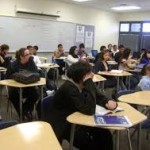
- Khan’s personal academic knowledge and experiences allowed him to envision the upside of educational experiences.
- He also investigated the views of learning experts.
- Deep knowledge of mathematics allowed Khan to create videos and tools to support his initial tutoring of extended familly. The same depth of knowledge allowed him to develop the initial “library” of videos for this first subject — with each video situated within the framework of one-step-at-a-time mastery.
Customer Knowledge
- The first customer knowledge came from Khan’s extended-family tutees. Working with them closely revealed not only particular knowledge gaps, but also just how limited a “grasp of core material” could be even for generally motivated and “successful” students.
- This early experience also provided informal “research subjects” as Khan addressed gaps and fundamentals with the family tutees. In turn, tutees provided constructive suggestions for improving the delivery of tutoring.
- You Tube viewers provided continuing input month by month, in terms of both rapidly increasing numbers and comments.
 A series of early school-based initiatives provided additional research-like experience. Khan was able to build information tools directly into the online video library and test the tools with teachers, as well as activities with students.
A series of early school-based initiatives provided additional research-like experience. Khan was able to build information tools directly into the online video library and test the tools with teachers, as well as activities with students.- In one school’s multi-class initiative with middle school students who had significant gaps in math understanding, a natural experiment allowed Khan to witness firsthand the extent of change, engagement, and gratitude prompted by systematic repair of their foundations.
- Before acquiring customer feedback like this, Khan didn’t think that learning’s upside would be of interest to students widely.
Human-Social Knowledge
- Conviction that virtually everyone has potential to master high-level learning.
- Recognizing the 21st century context of needs for learning — e.g., “deep creativity and analytical thinking … not luxuries but survival skills.”
Technology Knowledge
- Facile programming knowledge, which Khan called “simple,” but which allowed for envisioning immediate and emerging possibilities.
- Khan’s practical, hands-on programming began in his youth with a programmable calculator.
3. “How” Hypotheses
When Khan committed to the Khan Academy possibility, he made a big decision to resign from his Wall Street job and move with his wife to California’s Silicon Valley. That was in 2009.
Initial Priorities:
1. Core Value Proposition — Developing The Product
- Khan worked out of a closet in his home, focusing on producing a fuller menu of videos.
2. Revenue Stream
 At a minimum, Khan needed enough financial support to justify his own full-time commitment to the offering as he sought larger support.
At a minimum, Khan needed enough financial support to justify his own full-time commitment to the offering as he sought larger support.
- Khan was committed to “free” access to all customers, including an early decision to register the organization with “nonprofit” status and seek philanthropic support.
- The idea is to stretch the impact of the philanthropic dollars (based on donors finding compelling value in the offering’s potential to produce the impact).
- It took about a year to receive his first donation of $10,000, followed by $100,000 from the same donor.
- Khan described being “ding’d by about thirty foundations.”
- But large donations quickly followed the initial ones.
- The Bill & Melinda Gates Foundation’s office of Bill Gates contacted Khan to inquire about a meeting with Gates (who had used the videos to help one or more of his children with Math). The meeting led to robust financial support for truly launching the Khan Academy — scaling up the video library and staffing for overall impact and growth. (In 2015, the staff included some 80 full-time employees.)
- There was a special offering from Google to translate the videos into multiple languages.
3. Resources
- Khan’s first hire was a President & Chief Operations Officer — a longtime friend and likeminded learning enthusiast, who at the time was employed as a highly-paid McKinsey consultant.
- This first hire exemplified the approach of hiring based on shared conviction in the Academy’s “what could be” hypothesis. That conviction was to feed initial and ongoing “how” hypotheses.
4. Customer Segments
- Working with schools …
5. Channels for Publicizing Vision of “What Could Be”
- Authoring a book (The One World Schoolhouse) to describe (and promote) the Khan Academy’s vision, especially for education possibilities overall, with its own offering as one supporting element.
- Guest appearances and interviews (e.g., TED Talk, Tavis Smiley, New York Times, and many more) to do the same.
Sample Knowledge Connected in “How” Hypotheses:
Domain/Industry Knowledge
- … …
- … …
Customer Knowledge
- Learn from real teachers and students how our technology could be used or be made better.”
Human & Social Dynamics
- … …
- … …
Anything & Everything
- Silicon Valley as hub of technology-based startup ventures, including ecosystem of related resources.
- … …
4. Change By Way of Value
 Key resources to be used differently to produce the new value:
Key resources to be used differently to produce the new value:
- Khan and others’ academic knowledge and passion for learning and its applications.
- Philanthropic dollars
- Internet and other technology.
Nature of societal impact (fruits):
Direct outcome is more flourishing customers. More successful learning and empowerment for individual learners and schools. As of mid-2015, there were 20 million registered Khan Academy users around the world (double the number from a year prior).
For society, a potential catalyst for much more fruitful education system. For example, effective video dissemination of information frees physical classroom to “move up the value chain” to more interactive and hands-on learning.
For society, the video library allows for much broader access to education as well as to more successful learning. In Khan’s words: “How many Albert Einsteins didn’t we find”?”
Ultimately, to provide for more productive and fulfilled individuals throughout society.
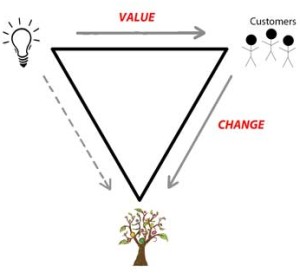
5. Value to Khan Academy Agents
Purpose larger than self but personally compelling, combined with equally compelling idea (grounded in knowledge) for addressing the purpose:
“(W)ithin a few short years, it had become clear to me that my passion and my calling were in virtual teaching.”
“Maybe I was delusional, but I dreamed of creating something enduring and transformative, an institution for the world that could last hundreds of years and help us fundamentally rethink how schooling might be done.”
“(W)hat really matters …is whether the world will have an empowered, productive, fulfilled population in the generations to come, one that fully taps into its potential and can meaningfully uphold the responsibilities of real democracy.” (p 5)
“(M)y heart was becoming fully invested with the potential of what the Khan Academy might be.” “Frankly, the possibilities surrounding the Khan Academy were so exciting that I had trouble doing my day job properly.”
“Problem-solving nuts and bolts approach. An engineer’s approach.” … Social engineer.
“Our mission is to provide a free, world‑class education for anyone, anywhere.”


